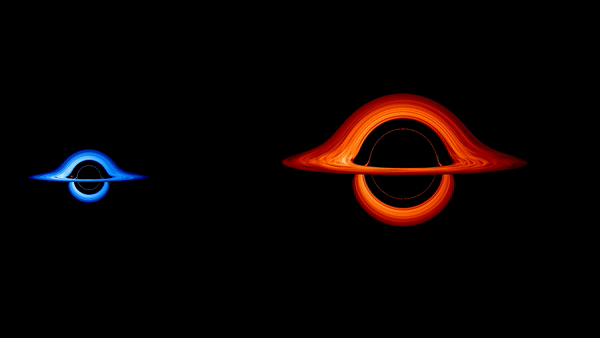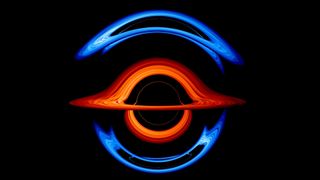Watch two black holes bend the daylights out of space-time in this trippy NASA visualization
Two black holes; one very warped tango.

When two orbiting supermassive black holes get close to each other, the results can be pretty twisted. A new NASA visualization shows how the irresistible pull of extreme gravity bends and distorts light in the glowing rings of hot gas circling the black holes in a simulated binary system.
The animation shows two black holes: The bigger of the pair, which is about 200 million times the mass of our sun, is surrounded by red rings of hot gas called an accretion disk. Orbiting that giant is a second black hole weighing in at about half of that mass, and its gas and dust rings are illustrated in bright blue.
Powerful gravitational forces tug and warp the fabric of space-time as one black hole orbits the other, bending the light from the dance partners' glowing accretion disks. And the closer you get to one of these warped giants in the simulation, the more contorted the other appears, NASA representatives said in a statement.
Related: 10 huge black hole findings
"Zooming into each black hole reveals multiple, increasingly distorted images of its partner," Jeremy Schnittman, an astrophysicist at NASA’s Goddard Space Flight Center (GSFC) in Greenbelt, Maryland, said in the statement.
The gravitational pull at the center of a black hole is so irresistible that not even light can escape. At its core is a dark region of infinite density known as the singularity, bounded by the event horizon. Just outside the event horizon, gravity bends photons into a curve known as the photon sphere. Spinning around that sphere is the accretion disk's rings of superheated gas and dust, whirling at incredible speeds and spitting out electromagnetic radiation, such as X-rays, radio waves, microwaves and gamma rays.
The visualization begins with an overhead view of the smaller black hole orbiting the larger one. At first, neither seems much affected by the closeness of the other, but that changes dramatically once the viewpoint shifts to the orbital plane. Now, when one black hole passes in front of the other, the light from the background object writhes and wraps to follow gravitational distortion. The visibly glowing colors in the visualization are artistic choices, as accretion disks in supermassive black holes would emit light in the ultraviolet range of the spectrum. In the less massive black hole — the blue one — gas in the disk would burn slightly hotter than in the heavier black hole, according to the statement.
Sign up for the Live Science daily newsletter now
Get the world’s most fascinating discoveries delivered straight to your inbox.

To create the simulation, Schnittman computed how light produced in the accretion disks would curve around the warped fabric of space-time during the black holes' dance. He calculated the frame-by-frame movements in about a day, using the Discover supercomputing cluster at the NASA Center for Climate Simulation at GSFC, according to the statement.
Most large galaxies are thought to have a supermassive black hole — one that is millions or even billions of times more massive than our sun — at their center. Binary systems for these monster black holes arise from galaxy collisions, though in most cases the black holes spiral together so that only a fraction of merged galaxies retain two orbiting black holes, NASA reported in 2018. In such systems where both black holes are supermassive, this funhouse-mirror distortion of glowing light could persist for a very long time, Schnittman said in the statement.
"These are the kinds of black hole binary systems where we think both members could maintain accretion disks lasting millions of years," he said.
Originally published on Live Science

Mindy Weisberger is an editor at Scholastic and a former Live Science channel editor and senior writer. She has reported on general science, covering climate change, paleontology, biology and space. Mindy studied film at Columbia University; prior to Live Science she produced, wrote and directed media for the American Museum of Natural History in New York City. Her videos about dinosaurs, astrophysics, biodiversity and evolution appear in museums and science centers worldwide, earning awards such as the CINE Golden Eagle and the Communicator Award of Excellence. Her writing has also appeared in Scientific American, The Washington Post and How It Works Magazine. Her book "Rise of the Zombie Bugs: The Surprising Science of Parasitic Mind Control" will be published in spring 2025 by Johns Hopkins University Press.
Most Popular


